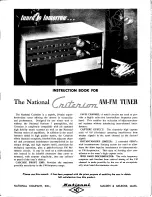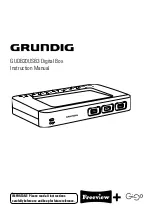
©2012 Hamtronics, Inc.; Rochester NY; USA. All rights reserved. Hamtronics is a registered trademark. Revised: 2/14/16
- Page 1 -
GENERAL INFORMATION.
The R303 is the latest in a series of popu-
lar receivers for demanding applications
which require exceptional sensitivity and se-
lectivity. It is especially suited for repeaters,
audio and data links, and remote control. The
R303 was designed to allow the factory to set
it on frequency without lengthy waits to ob-
tain channel crystals. It is a single-channel vhf
fm receiver available in several models for re-
ception in the 144 MHz ham band, the 138-
175 MHz commercial band, or 216-230 MHz.
On special order, up to three frequencies can
be programmed into the receiver allowing
jumpers to change channels.
The R303 is our 9th generation vhf fm re-
ceiver, and it packs in features you've told us
are important to you during our 45 years of
designing receivers. It's up to the difficult jobs
you've told us you have.
The R303 retains all of the popular fea-
tures Hamtronics
®
receivers have been noted
for. It uses triple-tuned circuits in the front
end and excellent crystal and ceramic filters in
the i-f with steep skirts for close channel spac-
ing or repeater operation. The i-f selectivity,
for instance, is down over 100dB at ±12 kHz
away from the carrier, which is 40-50 dB bet-
ter than most transceivers. Low noise fet's in
the front end provide good overload resis-
tance and excellent sensitivity.
The R303 is designed for narrow-band fm
with ±5 kHz deviation. Other bandwidths are
available on special order.
The R303 features a positive-acting, wide-
range squelch circuit and additional output
terminals for low-level squelched audio and
discriminator audio as well as COS.
The audio output will drive any load as
low as 8
with up to 1 Watt continuous out-
put. Volume and squelch are adjustable with
trim pots on the pc board. For those applica-
tions requiring adjustments on the outside of
a cabinet, you may easily replace these pots
with suitable panel mount controls.
The receiver may be used with either
voice or fsk data up to 9600 baud using an ex-
ternal data demodulator unit. An accessory
TD-5 CTCSS Decoder unit is available for sub-
audible tone control.
There are several models, which have mi-
nor variations in parts and microcontroller
programming, to provide coverage as shown
in table 1. The frequency is programmed in at
the factory and is aligned to frequency; so you
have no adjustments to do at installation.
The TCXO (temperature controlled xtal os-
cillator) provides a temperature stability of
±2ppm over a temperature range of -30°C to
+60°C.
INSTALLATION.
Mounting.
Some form of support should be provided
under the pc board, generally mounting the
board with spacers to a chassis. The receiver
board relies on the mounting hardware to
provide the dc and speaker ground connec-
tions to the ground plane on the board; so
metal standoffs and screws should be used for
mounting.
Electrical Connections.
Power and input audio or data signals
should be connected to the solder pads on the
pc board with #22 solid hookup wire, which
can be attached to a connector or feed-
through capacitors used on the cabinet in
which it is installed. Be very careful not to
route the wiring near the components on the
left hand side of the board, which contains
sensitive loop filter and vco circuits which
could pick up noise from the wiring.
Power Connections.
The receiver operates on +13.6 Vdc at
about 100 mA peak with full audio. Current
drain with no audio is only about 38 mA. A
well regulated power supply should be used.
Be sure that the power source does not
carry high voltage or reverse polarity tran-
sients on the line, since semiconductors in the
receiver can be damaged. The positive power
supply lead should be connected to the re-
ceiver at terminal E3, and the negative power
lead should be connected to the ground plane
of the board through the mounting hardware
or the shield of the coaxial cable. Be sure to
observe polarity!
Speaker.
An 8-ohm loudspeaker should be con-
nected to E2 with ground return through the
mounting hardware. Use of lower impedance
speaker or shorting of speaker terminal can
result in ic damage. The receiver can also
drive higher impedances, such as the 1K to
20K input impedances of repeater controller
boards.
Antenna Connections.
The antenna connection should be made
to the pc board with an RCA plug of the low-
loss type made for rf. We sell good RCA plugs
with cable clamp. See A5 plug on website.
If you want to extend the antenna con-
nection to a panel connector, we recommend
using a short length of RG-174/u coax with the
plug and keep the pigtails very short.
We do
not
recommend trying to use di-
rect coax soldered to board or another type of
connector. The method designed into the
board results in lowest loss practical. When
soldering the cable, keep the stripped ends as
short as possible.
We recommend you always use anten-
nas with a matching network which provides a
dc ground on the driven element to avoid stat-
ic buildup damaging the input stage of the re-
ceiver.
OPTIONS.
Repeater Use.
E5 provides a COS (carrier operated
switch) output which may be connected to a
COR module to turn a transmitter on and off.
The output level is about 5V unsquelched and
0V squelched. There is a resistor in series
with the output to limit current. Therefore,
the voltage that appears at the COR board will
depend on the load resistance at the input of
that board. For best results, be sure that the
input resistance of the COR board is at least
47K. If the input resistance is too low, no
damage to the receiver will occur; but the
squelch circuit hysteresis will be affected.
If your repeater controller uses discrimi-
nator audio, rather than the speaker output,
filtered discriminator audio is available at E4.
The level is about 2V p-p.
Note that discrimi-
nator audio is not de-emphasized or squelch-
ed.
If your controller uses low level audio and
has a high input impedance (20K or higher),
HAMTRONICS® R303 VHF FM RECEIVER:
INSTALLATION, OPERATION, & MAINTENANCE
Table 1. Quick Specification Reference
Frequency Range:
Can be supplied for any
frequency in range of 138-175MHz or 216-
230MHz.
Sensitivity
(12dB SINAD): 0.15 to 0.2µV
Squelch Sensitivity:
0.15µV
Normal signal bw:
±5kHz deviation
Adjacent Channel Selectivity:
±12 kHz at -100dB (narrower bandwidth avail-
able as an option)
Image Rejection:
60-70dB
Modulation Acceptance:
±7.5 kHz
Frequency Stability:
±2ppm -30°C to +60°C
Audio Output:
up to 1 Watt (8 ohms).
Operating Power:
+13.6Vdc (+10 to +15Vdc)
at 38-100 mA, depending on audio level.
Size:
4 in. W x 2-1/2 in. D

























